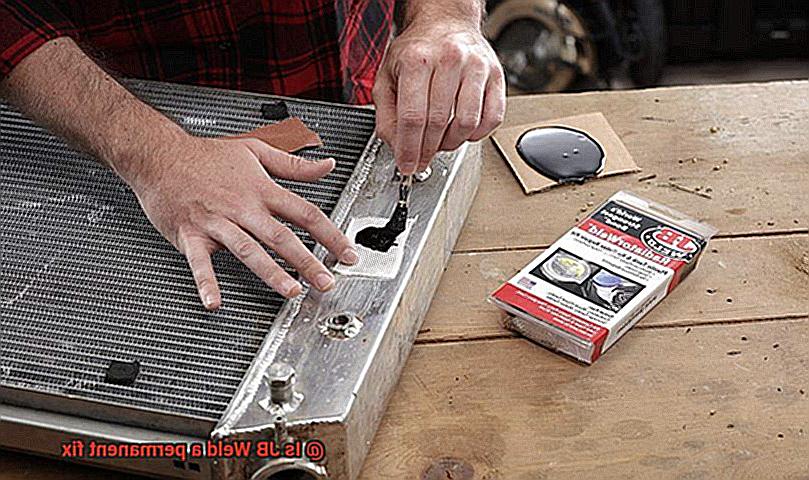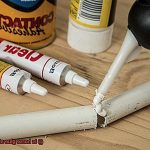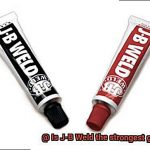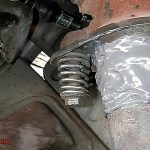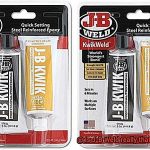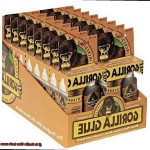Picture this: you’re knee-deep in a DIY project, desperately searching for a solution to your repair woes. Enter JB Weld, the adhesive superhero promising to save the day with its claims of being a permanent fix. It’s like the knight in shining armor that promises to patch up cracked exhaust manifolds and mend leaky pipes with unrivaled durability and strength. But hold on a minute, is JB Weld really as invincible as it claims to be?
In this blog post, we’ll dive deep into the world of JB Weld and uncover the truth behind its permanence. We’ll explore both sides of the coin, weighing its effectiveness against potential drawbacks. We’ll also take into account those sneaky factors that could impact its longevity – because let’s face it, nothing lasts forever.
So grab your tool belt and get ready for an informative adventure. By the end of this post, you’ll have all the knowledge you need to make an informed decision about whether JB Weld is truly the hero your repairs deserve or just another temporary fix in disguise.
What is JB Weld?
Contents
- 1 What is JB Weld?
- 2 Is JB Weld a Permanent Fix?
- 3 Factors that Affect the Permanence of JB Weld
- 4 Surface Preparation for Effective Bonding
- 5 Material Compatibility for JB Weld
- 6 Application Process for Long-lasting Repairs
- 7 Limitations of JB Weld as a Permanent Fix
- 8 Tips to Ensure a Permanent Repair with JB Weld
- 9 Conclusion
When it comes to repairs, having a reliable adhesive is crucial. One name that stands out in the world of adhesives is JB Weld. But what exactly is JB Weld, and why is it such a popular choice for repairs? In this article, we’ll dive into the world of JB Weld and explore its unique properties that make it a go-to adhesive for DIY enthusiasts, hobbyists, mechanics, and professionals alike.
Versatility and Strength:
JB Weld is a powerful epoxy adhesive that can bond various materials together, such as metal, wood, plastic, ceramic, and more. Whether you need to fix a broken pipe or repair a cracked engine block, JB Weld can handle the job. Its high strength sets it apart from other adhesives, often forming a bond stronger than the materials being joined. This makes it ideal for heavy-duty repairs that require durability and longevity.
Easy Application and Modifications:
Using JB Weld is a breeze. It consists of two components – a resin and a hardener – that need to be mixed in equal parts before use. Once mixed, you have a short working time to apply the adhesive before it starts to cure. Following the manufacturer’s instructions carefully ensures optimal results.
What sets JB Weld apart from other adhesives is its ability to be modified after curing. Once fully cured, it can be sanded, painted, drilled, tapped, machined, and filed. This means you can achieve a seamless finish on repaired surfaces or make additional adjustments as needed.
Reliability in Challenging Conditions:
JB Weld’s reputation extends beyond its versatility and strength; it also excels in challenging conditions. It can withstand extreme temperatures, chemicals, water, and vibrations. This makes it suitable for a wide range of applications, from automotive repairs to plumbing projects.
Limitations:
While JB Weld is a powerful adhesive, it’s important to note its limitations. It may not bond effectively with certain types of plastics or materials with low surface energy. Additionally, exposure to extreme temperatures, UV radiation, or constant stress can weaken the bond over time.
Is JB Weld a Permanent Fix?
JB Weld is renowned for its reputation as a strong and durable adhesive that can deliver long-lasting repairs. However, it’s essential to recognize that JB Weld may not always provide a permanent fix. The effectiveness of JB Weld as a permanent solution depends on several critical factors.
Firstly, it is crucial to consider the type of material being repaired. While JB Weld is capable of bonding metal, wood, plastic, and other materials, it may not be suitable for applications requiring flexibility or movement. For instance, if you’re fixing a flexible plastic part that needs to bend or flex, JB Weld may not be the best choice.
Moreover, the extent of the damage plays a role in determining whether JB Weld will offer a permanent fix. If the damage is extensive or structural in nature, relying solely on JB Weld might not be sufficient. In such cases, reinforcing the repair with additional support or seeking professional assistance may become necessary.
Following the manufacturer’s instructions diligently when using JB Weld is also crucial. Proper surface preparation, correct epoxy mixing, and sufficient curing time are essential for achieving a strong and lasting bond. Failure to adhere to these instructions can compromise the durability of the repair.
Furthermore, while JB Weld provides a robust bond, it may not always be aesthetically pleasing. The epoxy dries to a gray or dark color, which may not blend well with certain materials or finishes. Therefore, if appearance is a priority, exploring alternative repair methods might be necessary.
In some instances, JB Weld may require additional reinforcement or support to enhance its strength and longevity. Using mechanical fasteners or other bonding agents in conjunction with the epoxy adhesive can provide added durability to the repair.
Ultimately, the permanence of a JB Weld repair depends on various factors such as the quality of the initial bond, the conditions in which it is used, and how well it is maintained over time. If you require a more permanent fix or have specific requirements such as load-bearing capabilities or an expected lifespan, alternative methods like welding or professional repairs may be a better choice.
Factors that Affect the Permanence of JB Weld
When it comes to repairing broken items or joining materials, JB Weld is often hailed as the superhero of adhesives. But what makes this adhesive so strong and reliable? In this article, we will delve into the various factors that can affect the permanence of JB Weld, ensuring you achieve the best results for your projects.
Surface Preparation: A Solid Foundation
Just like a house needs a strong foundation, a successful JB Weld bond begins with proper surface preparation. Cleanliness is key – ensure that the surfaces to be bonded are clean, dry, and free from any contaminants that could compromise adhesion. Think of it as giving JB Weld a clean canvas to work its magic. Take the time to clean the surfaces with a suitable solvent and remove any loose particles or corrosion using sandpaper or a wire brush.
Mixing Ratio: The Perfect Symphony
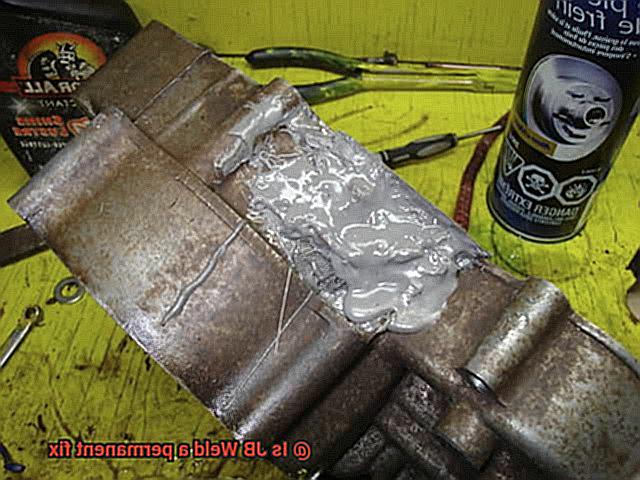
JB Weld consists of two components – a resin and a hardener. To unlock its full strength potential, it’s crucial to mix these components in the correct ratio as specified by the manufacturer. Think of it as creating a perfect symphony – deviating from the recommended mixing ratio can result in an incomplete or weak bond, affecting its overall permanence. So, measure twice and mix with precision to ensure JB Weld performs at its best.
Temperature and Curing Time: The Waiting Game
Patience is a virtue when it comes to JB Weld. Temperature plays a pivotal role in its curing process. Follow the manufacturer’s instructions regarding temperature requirements and curing times. Higher temperatures can accelerate the curing process, while lower temperatures may slow it down. Allow sufficient curing time for the bond to reach its maximum strength before subjecting it to any stress or load. Remember, good things come to those who wait.
Material Composition: Compatibility Matters
JB Weld is renowned for its versatility, but not all materials are created equal when it comes to bonding. Compatibility matters – consult the manufacturer’s guidelines or conduct a small test on a discreet area to determine how well JB Weld adheres to specific materials. This will ensure compatibility and maximize its effectiveness. After all, a strong bond relies on finding the perfect match.
Environmental Factors: Battling the Elements
JB Weld may seem invincible, but it’s not impervious to environmental factors. Extreme conditions like high humidity or constant immersion in water may weaken the bond over time. Similarly, exposure to high temperatures or harsh chemicals can cause degradation or weakening of the adhesive properties. Consider the intended application and potential environmental conditions when assessing the permanence of JB Weld. It’s all about preparing for battle against the elements.
Surface Preparation for Effective Bonding
Surface preparation is a critical step in achieving effective bonding with adhesives like JB Weld. It involves cleaning and roughening the surfaces to create an optimal bonding environment.
The first step in surface preparation is thorough cleaning. Contaminants such as grease, oil, dirt, and rust can hinder the bond, so it’s crucial to remove them. Using a suitable solvent or degreaser, give the surfaces a good scrubbing to ensure they are squeaky clean.
After cleaning, it’s time to roughen the surfaces. Think of it as giving the adhesive something to hold onto. Grab some sandpaper or a wire brush and remove any loose paint, rust, or corrosion. This creates a slightly roughened surface that provides more area for the adhesive to grip onto. It’s like giving your adhesive a little playground to cling onto.
Once the surfaces are clean and roughened, it’s important to wipe away any dust or debris. You don’t want anything getting in the way of that perfect bond, do you? Grab a clean cloth or rag and give those surfaces one final wipe-down.
In some cases, especially with non-porous materials like metals or plastics, additional help may be needed. This is where primers and adhesion promoters come in. These products enhance adhesion on tricky surfaces by promoting chemical bonding between the adhesive and the substrate. It’s like giving your bond an extra boost of strength.
Remember, different adhesives may have specific requirements for surface preparation. Always read the instructions and follow them to a T. There’s nothing worse than a subpar bond, right?
So there you have it. Surface preparation is the secret sauce to achieving an effective bond with JB Weld. Clean those surfaces, roughen them up, and consider using primers or adhesion promoters if needed. By doing so, you’ll ensure a strong and durable bond that will withstand the test of time.
Material Compatibility for JB Weld
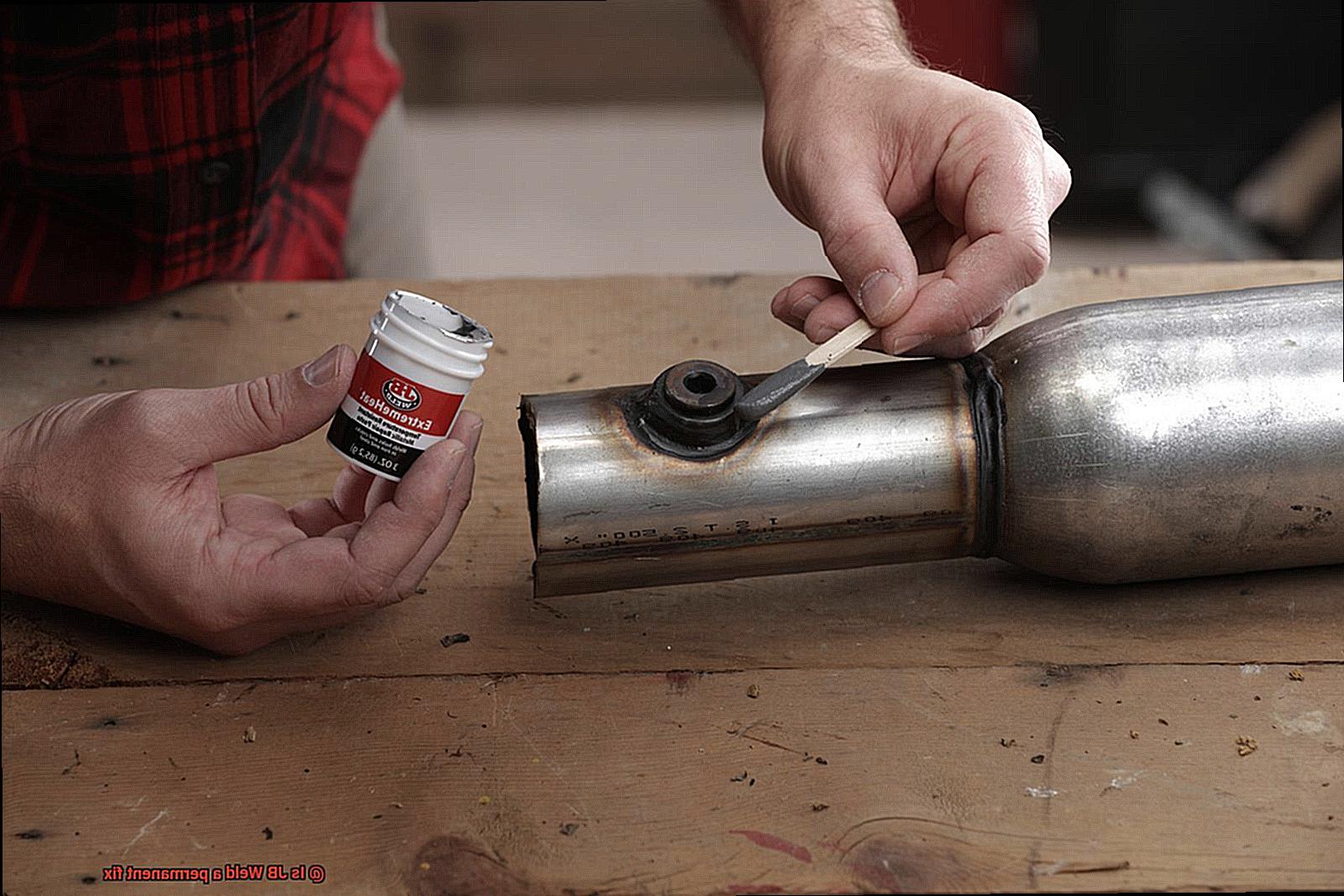
Look no further than JB Weld, the ultimate adhesive that can fix almost anything. In this article, we will explore the material compatibility of JB Weld and how it can benefit your repair projects. So, let’s dive in.
Metal Compatibility:
JB Weld is a great choice for bonding various metals, including steel, iron, copper, aluminum, and brass. It effortlessly joins metal pieces or repairs cracks and holes. Just ensure a clean surface free from oil or grease for optimal adhesion.
Plastic Compatibility:
JB Weld handles all plastics like PVC, ABS, acrylic, and more. It excels at repairing cracked or broken plastic parts found in automotive components, plumbing fixtures, or household items. Thoroughly clean the surface and consider additional steps like sanding for better adhesion.
Wood Compatibility:
JB Weld is a reliable option for fixing cracks or joining wooden pieces together. It works well with both hardwoods and softwoods. However, seek alternative solutions for load-bearing structures as JB Weld’s adhesive strength may not be sufficient.
Ceramic Compatibility:
Broken pottery? Cracked porcelain? Don’t worry. JB Weld can come to your rescue. Properly clean the ceramic surface and use a mild abrasive if necessary to restore your beloved objects.
Other Materials:
JB Weld isn’t limited to just metal, plastic, wood, and ceramic. It can also be used on glass, fiberglass, concrete, and more. Follow the manufacturer’s instructions and consider specific compatibility requirements for each material.
Application Process for Long-lasting Repairs
Look no further than JB Weld, the ultimate long-lasting repair remedy. In this comprehensive guide, we will walk you through the step-by-step application process for utilizing JB Weld to ensure successful and enduring results.
Preparation is paramount. Prior to applying JB Weld, thoroughly cleanse and prepare the surfaces in need of repair. Rid them of any pesky dirt, greasy residue, or loose material that could hinder adhesion. For an even more robust bond, gently roughen the surface with the aid of sandpaper or a wire brush.
Now, it’s time to blend the two powerful components of JB Weld – the epoxy resin and the hardener. Exercise utmost care by meticulously following the manufacturer’s instructions to achieve the correct ratio. Once mixed, promptly apply the concoction to the prepared surfaces. To simplify application, contemplate utilizing a disposable tool like a wooden stick or plastic spatula.
Spread JB Weld evenly across the damaged area, ensuring complete coverage while simultaneously filling any gaps or cracks. This meticulous approach will establish a sturdy foundation for your repair.
After skillfully applying JB Weld, grant it ample time to cure. The duration of curing may fluctuate depending on factors such as temperature and humidity; therefore, consult the manufacturer’s instructions for precise guidelines. During this crucial period, be mindful to avoid any motion or disturbance of the repaired area to safeguard the bond formed by JB Weld.
Once fully cured, JB Weld forms an astonishingly potent and enduring connection that withstands an array of strains and pressures. It’s akin to arming your repair with superpowers. If aesthetics hold significance for you, fret not – JB Weld can be sanded down and painted after curing, allowing for further refinements if desired.
Limitations of JB Weld as a Permanent Fix
Today, we will embark on a journey through the realm of adhesives as we delve into the limitations of the beloved superhero glue – JB Weld. While this mighty adhesive can perform wonders in various situations, it is crucial to comprehend its boundaries as a permanent fix. So, let us begin.
First and foremost, let us discuss the challenge of heat. JB Weld boasts an impressive heat resistance of up to 550 degrees Fahrenheit. However, when it comes to projects involving extreme temperatures like automotive engine repairs or exhaust systems, JB Weld may not be the most suitable long-term solution. Prolonged exposure to high temperatures can weaken the epoxy and eventually lead to failure.
Next on our agenda is chemical resistance. Although JB Weld can withstand some chemicals, there are others that can gradually break down its bond over time. Gasoline, brake fluid, and certain acids are prime examples of substances that can weaken or dissolve JB Weld. Therefore, if your project entails exposure to these chemicals, it would be wise to explore alternative adhesives or repair methods.
Flexibility poses another limitation for JB Weld. Once cured, it becomes rigid and may crack or break under constant motion or vibrations. Consequently, if you are repairing something flexible or an area that experiences frequent movement, it is advisable to seek other options.
Proper surface preparation is pivotal for achieving optimal adhesion with JB Weld. Ensure that the surfaces you intend to bond are clean, dry, and devoid of any grease, oil, or debris. Neglecting this crucial step can result in a weaker bond and diminish the longevity of your repair.
Lastly, we must acknowledge that no adhesive is truly permanent. Over time, factors such as aging, UV exposure, and mechanical stress can all contribute to the deterioration of the bond created by JB Weld. It is prudent to monitor repaired areas periodically and be prepared for potential reapplication or further repairs in the future.
Tips to Ensure a Permanent Repair with JB Weld
JB Weld is a trusted epoxy adhesive known for its ability to provide a strong and durable bond. To ensure a permanent repair with JB Weld, it is important to follow specific tips and techniques. In this article, we will explore these tips and explain how they can help you achieve long-lasting results.
Prepare the Surface:
Before applying JB Weld, thoroughly clean the surfaces you are bonding. Remove any dirt, grease, or debris using a degreaser or rubbing alcohol. A clean surface is crucial for proper adhesion and a strong bond. Think of it as laying a solid foundation for your repair.
Roughen Up the Surfaces:
To enhance the bond between JB Weld and the surfaces being repaired, roughen them up slightly. Lightly sand the surfaces with sandpaper or use a wire brush to create a rough texture. This increases the surface area for JB Weld to grip onto, resulting in a stronger bond. Imagine it as creating tiny hooks for the epoxy to grasp.
Mix the Epoxy Properly:
Achieving maximum bonding strength with JB Weld relies on mixing the epoxy components correctly. Follow the instructions provided and mix the resin and hardener in the right ratio. Thoroughly combine them until you achieve a uniform color and consistency. This ensures that the epoxy cures properly and bonds effectively, like two souls merging into one.
Apply Thin Layers:
When applying JB Weld, remember that multiple thin layers are better than one thick layer. Thin layers allow each layer to cure properly before adding another, creating a stronger overall bond. They also prevent air bubbles from getting trapped in the epoxy, resulting in a smooth and uniform repair. It’s like building layer upon layer of armor, making your repair bulletproof.
Provide Support during Curing:
While JB Weld cures, provide support to the repaired area. Use clamps or weights to hold the bonded parts together, ensuring constant pressure on the joint. This promotes better adhesion and helps the epoxy cure evenly. It’s like holding hands with someone during a challenging time, providing strength and support.
Allow Proper Curing Time:
Patience is crucial when working with JB Weld. Follow the manufacturer’s instructions regarding curing time and allow the epoxy to fully cure before subjecting it to any stress or load. Rushing the process can result in a weaker repair. It’s like waiting for a flower to bloom, giving it time to reach its full potential.
kDT02YamWdE” >
Conclusion
In conclusion, JB Weld can indeed be considered a permanent fix for many applications. Its strong bonding properties and resistance to heat, pressure, and chemicals make it a reliable choice for repairing various materials. Whether you need to fix a cracked engine block or mend a broken metal tool, JB Weld can provide a long-lasting solution.
But let’s not forget that permanence is relative. While JB Weld offers exceptional durability, it may not withstand extreme conditions or constant stress indefinitely. Factors such as temperature fluctuations, vibrations, and the specific materials being repaired can affect its longevity.
That being said, when used correctly and in appropriate circumstances, JB Weld can provide a lasting repair that will hold up well over time. It is important to follow the instructions carefully and ensure proper surface preparation for optimal adhesion.
So, while we can confidently say that JB Weld is a reliable and effective option for many repairs, it’s always wise to consider the specific situation at hand. If you’re unsure whether JB Weld is suitable for your particular application or if you require an absolutely permanent solution, consulting with a professional or considering alternative options may be advisable.
In the end, JB Weld offers a powerful adhesive solution that can serve as an excellent permanent fix in numerous scenarios.

